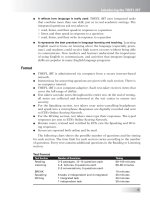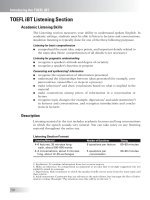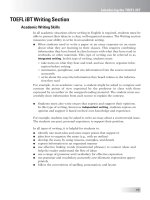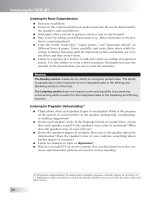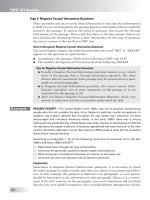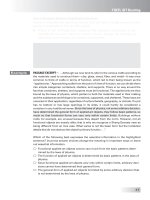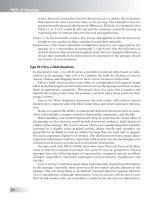Ebook The controllers function The work of the managerial accountant (third edition) Part 2
Bạn đang xem bản rút gọn của tài liệu. Xem và tải ngay bản đầy đủ của tài liệu tại đây (13.2 MB, 242 trang )
12
RECEIVABLES
Accounts receivable are an important item in the balance sheets of most
business concerns and must be carefully controlled to avoid excessive working capital requirements. Proper procedures and adequate safeguards on
these accounts are essential not only to the continued success of the enterprise but also to satisfactory customer relationships. Control of accounts
receivable begins before the agreement to ship the merchandise, continues
through the preparation and issuance of the billing, and ends with the collection of all sums due. The procedure is closely related to cash receipts control
and inventory control, acting as the link between the two. This chapter introduces ways to measure, manage, and control the receivables function.
FUNCTIONS OF THE CREDIT DEPARTMENT
The credit manager should assist in stimulating business through a wise
extension of credit and also keep bad debt losses at a reasonably low level.
The credit manager is also responsible for collecting receivables. In detail,
the credit department’s tasks are to:
• Establish credit policies. This involves such questions as the class of
risk to accept, rigidity of credit term enforcement, and adjustment policies to be followed.
• Investigate credit. This requires a continuous procedure for securing
and analyzing information concerning the responsibility of present and
prospective customers. Information about customers can be collected
from:
⅙
Commercial credit reporting agencies, such as Dun & Bradstreet
219
220
Receivables
⅙
⅙
⅙
⅙
⅙
Trade references supplied by the customer
Banks that hold a customer’s loans, investments, and checking
accounts
Collection agencies
The SEC’s reports on any companies that issue stock or bonds to the
public
The annual financial report files of the stock exchanges for those
companies they list for trade
• Approve credit. This requires a procedure by which the credit department definitely approves new customers and regularly reviews the
credit of old ones.
• Establish credit limits. Usually approval is limited to a certain amount,
and a plan must be designed to check the extension of credit at this point
or at least to notify the proper authority when the limit is reached. In
addition, there will be situations when credit terms should not be
granted, but the sale can still be made. In these cases, the company can
either sell for cash or have backup guarantees by an individual, a second
corporation, or a standby letter of credit.
• Enforce discount terms. Customers frequently take discounts offered
for prompt payment after the time allowed. A policy must be established and a procedure designed for the enforcement of the discount
terms.
• Collect receivables. Definite collection steps must be arranged for slow
and delinquent accounts. This involves schedules of collection letters,
follow-up procedures, and suspension of accounts from approved lists. In
addition, the collections staff should be updated regularly on special collection techniques (i.e., attention-getting telegrams) and sent to trade
association meetings to swap information with collection personnel from
other companies.
• Adjust credit. This involves settlement of accounts, participation in
creditors’ committees, and representation in receivership and bankruptcy proceedings. Also, responsibility for writing off bad accounts
must begin with the credit departments, although final approval may
be required from the treasurer or controller, in the interest of sound
internal accounting control.
• Maintain credit records. Files, reports, and ratings must be maintained as part of the credit analysis and collection effort.
Functions of the Credit Department
• Manage the collection process.
managed collections process:
⅙
⅙
⅙
⅙
221
These items contribute to a tightly
Rapid billings. Quick billings lead to shorter days’ receivables
outstanding, whereas extremely delayed billings may be difficult to
collect.
Rapid cash application. The job of the collections clerk is greatly
facilitated when cash receipt information is quickly updated and forwarded to the collections staff. This avoids unnecessary calls on supposedly delinquent accounts that have actually already been paid.
Tickler file. This file informs the collections clerk of the need to
call customers on specific dates.
Confirmation letters. When a collection agreement is complicated, it is best to summarize the agreement terms in a letter and
send it to the customer immediately, so there will be no confusion
regarding payment.
• Measure the collection process. Understanding of the collection
department’s performance must be gained not only through quantitative measures, such as days’ sales outstanding (DSO) and the percentage of overdue invoices. A review of bad-debt write-offs will indicate
other problems, such as the reasons why credit was granted to customers who later defaulted. If these problems are tracked and corrected, then the volume of collection items will decline, thereby
enhancing the quantitative performance measures.
An in-depth knowledge of the business may reveal reasons for large receivables balances that have nothing to do with high-risk customer accounts.
For example, the DSO can be skewed by one very large invoice or by a
large cluster of billings that occur at one time, such as at month-end. Also,
a factoring arrangement may cause an abnormally low DSO.
The credit analyst typically makes credit decisions with the assistance of
customer financial statements. When doing so, these are the items to look for:
• Ratios. These ratios show where cash is being tied up in a customer’s
organization, thereby not allowing cash availability for debt payments:
⅙ Days’ sales outstanding. If the customer’s DSO is greater than its
days of selling terms plus a third, then too much cash is tied up in
receivables.
⅙ Quick ratio. If the customer’s quick ratio falls below 2 to 1, then
the ability to pay may be hindered.
222
Receivables
⅙
⅙
Inventory turnover. If the customer’s inventory turns are worse than
the industry norm, then too much cash is being tied up in inventory. The
presence of obsolete inventory is sometimes indicated by low inventory
turns accompanied by a good current ratio (since the excessive inventory
appears in the numerator of the current ratio calculation). Alternatively,
if a company has good inventory turns but a poor current ratio, it may
have too little working capital to support the level of business being
transacted (called over-trading); if so, look for high debt levels or call
the customer’s bank for information. This type of company is a dangerous trading partner, for its heavy debt load may cause it to crash quickly
if its level of business drops.
Debt ratio. If the customer’s total liabilities are greater than 100%
of equity, then the equity cushion available for payments to creditors is too small.
• Seasonality. Typically a company’s books are closed during the
slowest time of the year, when inventories are at their lowest, receivables have been collected, and debt has been paid down. If a company
chooses to have its year-end in a different month from other companies
in its industry, its key ratios may vary dramatically from industry
norms, even though it may operate in a similar manner.
• Trends. If possible, the credit analyst should obtain the last three
annual financial statements from key customers, and look for these
danger signs that indicate where cash is being used and is therefore not
available for payments:
⅙
⅙
⅙
⅙
Decrease in inventory turnover.
Increase in the collection period.
Increase in the ratio of total liabilities to equity.
Increase in the rate of working capital turnover. This is when sales
increase, but the amount of working capital remains the same. Debt is
usually substituted for the needed working capital, which increases
fixed costs and therefore the risk to the creditor.
SHORTENING THE RECEIVABLES CYCLE
The cash manager is interested in getting cash payments into the company
bank accounts as quickly as possible. The credit manager and the accounting department require transaction data that permit application of the payment to the proper account and invoice. Hence, cash acceleration procedures
Shortening the Receivables Cycle
223
must address both of these concerns. These methods are used to accelerate
collections.
• Lockbox. A lockbox is a post office box opened in the name of the
seller but accessed and serviced by a remittance processor. Banks and
others who process the remittances usually do so in a manner and at
the time of day that allows funds to be more readily available to the
depositor. Lockboxes offer these advantages over processing deposits
at the premises of the seller:
⅙
⅙
⅙
⅙
⅙
Faster availability of the funds.
Greater security over the remittance.
Reduced processing costs.
Greater reliability in deposit processing.
Greater reliability in capturing necessary remittance data. Image processing involves capturing the image of the check and temporarily storing it in digital form. This enables the bank to immediately dispatch
the check for clearing, while it uses the image to complete its work.
• Wire transfer. This is a series of telegraphic messages between two
banks, usually through a Federal Reserve bank, wherein the sending
bank instructs the Federal Reserve bank to charge the account of the
receiving bank and advises the receiving bank of the transfer.
• ACH (automatic clearinghouse) transfer. This system, operating under
the auspices of the National Automatic Clearing House Association, is a
method for the commercial banks to exchange electronic payments
without the high cost of Federal Reserve wires. In most instances the
payroll initiates a payment for credit to the bank account of the payee.
• Depository transfer check (DTC). Under this system, a bank prepares
a DTC check on behalf of its customer against the customer’s depository account in another bank. It is a means of getting funds from
depository accounts into concentration accounts more quickly.
• Preauthorized draft (PAD). This is a draft drawn by the payee
against the bank account of the payor. The method often is used by
insurance companies or other lenders where the payment is fixed and
repetitive. The payor must authorize its bank to honor the draft, which
may be in either electronic or paper form.
Accelerating the cash collections is one means of reducing the receivables.
In fact, if sales personnel are involved in collections, an incentive based on
customer payment habits might be considered. However, the amount of funds
224
Receivables
tied up in receivables may result in part from antiquated or slow procedures
in the order and billing process and not in the collection cycle. A detailed
review of the procedures from receipt of the customer order, through shipment, to cash collection might be helpful in spotting areas for improvement.
For example, in a typical manufacturing company, each step in the procedures from receipt of the customer order until final collection should be studied for means of expediting. Thus, these events ought to be analyzed for
means of speeding up the process:
• Order receipt steps, such as processing the customer order from receipt
in the mailroom or order department to the sales department
• Order processing steps in the sales department, such as separation of
stock orders from custom orders
• Credit approval steps, such as the segregation of orders to be expedited
and the separation of orders for known creditworthy customers
• Order shipping procedures, such as reviews by the shipper of a credit
hold list prior to shipping product
• Order paperwork flow from the shipping department to the billing
department
• Invoice preparation and mailing procedures
Given the advent of the microcomputer and the development of related
software that integrates the financial system, the many advantages of a simple computerized system should be considered. For example, billings and
month-end statements may be sent out more promptly. The more quickly
invoices are sent out, the more quickly they are paid. Invoices should always
be mailed within one day of the shipment date. Moreover, up-to-date records
make management information more accurate. Customers may be incorrectly dunned for overdue payments, when funds may have already been
received but not recorded. If records are not updated by the clerical staff, a
computer system will not prevent this problem but it will make the process
easier. Also, billings can be sent by electronic data interchange (EDI). EDI
allows the company to send invoices electronically to a central computer
clearinghouse, where the invoice is electronically stored. Customers access
the clearinghouse by modem and receive the invoice electronically.
RESERVE FOR DOUBTFUL ACCOUNTS
The accounts receivable investment includes providing a reserve for estimated doubtful accounts. This may be accomplished in one of two ways
Receivables Fraud and Control
225
when actual sales are made. First, a percentage of monthly sales (or credit
sales) can be set aside based on past experience. Second, the accounts
receivable aging and reserve should be reviewed for any probable uncollectible accounts. When dealing with the long-term business plan, the estimated
percent of sales is the method most commonly employed.
RECEIVABLES FRAUD AND CONTROL
The controller’s first experience with fraud may be the review of “what
went wrong” following the loss of assets. To avoid this problem, we provide a list of typical receivables frauds that the controller can prepare for
through proper control systems, which are also mentioned. With proper
controls, it should be much more difficult to perpetrate many of the frauds
listed below.
Receivables Fraud
These examples should not be considered the only possible types of receivables fraud; dishonest people will continue to derive new methods of removing money from a company. Thus the controller must remain watchful.
• Ship materials to a false address and do not issue an invoice. Collusion
is usually required, with one person in accounting and one person in
the shipping department.
• Issue an invoice to a customer at a high price and record an invoice for the
company’s records at a lower price; when payment is received, the
employee pockets the difference between the price paid and the price
recorded. To do this, an employee must have control over the billing and
cash receipts functions.
• Increase receivable balances with bogus transactions in order to procure loans secured against receivables. This can be accomplished by
one billings person.
• Write off artificial discounts and adjustments; when full payment
comes in, pocket the difference between the discounts and the full payment. To do this, an employee must have control over the billing and
cash receipts functions.
• Write off receivables as bad debts; when full payment comes in, pocket
the written-off amount. To do this, an employee must have control over
the billing and cash receipts functions.
226
Receivables
Receivables Controls
There is a risk that some deliveries to customers will not be billed to them.
Further, even though an invoice is prepared, the customer may be billed for an
incorrect amount because of differences in the quantity shipped, price, or
extensions. The controller must institute proper procedures to ensure that
such risks are minimized. These procedures may be useful in controlling
these receivables problems:
• Compare source information. Invoices to customers are compared to
prenumbered shipping memos by an independent party. This comparison includes both the quantity and the description of goods shipped,
and all shipping memo numbers must be accounted for.
• Audit prices and extensions. Prices appearing on invoices are independently checked against established price lists, and all extensions
and footings are checked.
• Compare detail to summary records. Periodically, the detail of the
accounts receivable is checked against the general ledger total and reconciled, preferably by an internal auditor or other independent party.
• Confirm balances. Surprise mailings of monthly statements and confirmation requests should be made by third parties.
• Segregate duties. All handling of cash should be segregated from the
maintenance of receivable records.
• Review special adjustments. All special adjustments for discounts,
returns, or allowances should have special approval.
• Review bad debts. A special record should be kept of all bad debts
written off, and a follow-up should be made on those items to minimize the danger of collections being received and not recorded.
• Mail invoices separately. Invoices may be mailed to customers by a
separate unit.
13
INVENTORY
Inventory can be one of the largest dollar items listed on the balance
sheet. It can be the cause of large and unexpected adjustments in the yearend financial statements, due to unexpected amounts of obsolete and
missing stock. In fact, supporters of just-in-time (JIT) manufacturing systems consider inventory to be a liability, since it is expensive in terms of
insurance, storage space, moving costs, obsolescence, shrinkage, tracking
costs, and working capital. Under the JIT system, minimal inventory
reduces all of the above costs. Because minimal inventory and highly
accurate inventory records are critical under any manufacturing system,
this chapter focuses on installing inventory tracking systems, which can
then be used to pinpoint inventory problems and lead to smaller inventories. In addition, this chapter discusses the valuation of inventories, the
physical inventory procedure, and inventory fraud.
INVENTORY MANAGEMENT SYSTEMS
Inventory management systems are a topic of considerable debate, as JIT
systems gradually supplant material requirements planning (MRP) and various reorder point systems. This section examines:
• The turnover statistic, which is the most universally used benchmark
for analyzing the performance of an inventory management system
• Overviews of each management system, as well as the advantages and
disadvantages of each one
• The cost of carrying inventories, as well as where responsibility for
inventory systems should lie
227
228
Inventory
Turnover
Turnover is the most universal measure of the manufacturing system’s efficiency in using inventory. It is derived by dividing the usage factor by the
average inventory. For example, the turnover of various inventories can be
determined:
• Finished goods. Cost of goods sold/average inventory of finished goods
• Work-in-process. Cost of goods completed/average inventory of workin-process
• Raw materials. Materials placed in process/average inventory of raw
materials
• Supplies. Cost of supplies used/average supply inventory
The result is the number of “turns,” usually measured in turns per year.
Turnover statistics must be analyzed with caution, for several factors can
cause the same result. A slow turnover can indicate overinvestment in
inventories, obsolete stock, or declining sales. A very high turnover can
indicate improved utilization through conversion to a JIT or MRP system,
or it may be caused by keeping an excessively small amount of stock on
hand, resulting in lost sales or increased costs due to fractional buying.
The purpose of business is turning a profit, not turning inventory. Evaluating a company’s performance based on a turnover is not wise without
more detailed information. If turnover is used to evaluate the performance
of a new manufacturing system, such as MRP or JIT, then it is useful. If it is
used to compare performance between accounting periods, it is useful as an
indicator of underlying problems or improvements that must be researched
further to determine the exact causes of any changes in the statistic.
Reorder Points
When there are known requirements, MRP and JIT systems will indicate
when materials need to be ordered, and inventories can be planned accordingly. When there is greater uncertainty, as in job-lot work, estimates of the
volume level must be made, and a provision for error, through the use of
safety stock, may be used. The reorder point is then calculated by multiplying the anticipated lead time in weeks by the estimated demand in units per
week, plus a safety stock quantity. Reorder point systems tend to result in
excess inventories and obsolete materials, because parts will be ordered
automatically even though the need for them may be declining. Typical
Inventory Management Systems
229
turnover rates to be expected are three to six turns, although this statistic
varies widely by industry.
At the time the stock level reaches the reorder point, a requisition is
issued for additional inventory. Some of the more widely used means of
signaling the time to reorder include:
• Minimum–maximum system. This method is used in connection with
the inventory record. The minimum quantity level is the reorder point;
the maximum level is the minimum quantity plus the economical order
size.
• Reserve stock method. Under this system, the stock is divided into
two parts: one for immediate use and one as a reserve. When use of the
reserve is begun, additional stock is reordered. This system may
involve two bins (one with the reserve stock) or one bin with the
reserve stock identified (e.g., in a separate bay).
• Visual check system. When a manager with direct knowledge of the
business activity checks the stock level, he or she can judge when to
reorder.
• Reservation method. This method recognizes the available stock as
well as the physical stock. Available stock is defined as stock on order,
plus physical stock, less the unfilled requirement. The reorder point is
based on the available stock rather than the physical stock.
Material Requirements Planning
Inventory is handled differently under the material requirements planning
system. An MRP system schedules production through a master schedule.
The system then multiplies the master schedule quantities by the bills of
material for each item on the schedule to determine the gross part requirements for production needs. The gross requirements are then reduced by
unallocated parts currently in stock to derive the list of parts to be ordered.
The to-be-ordered list is grouped into convenient lot sizes, and the parts are
ordered. Typical turnover rates to be expected are 6 to 15 turns, although
this statistic will vary widely by industry.
The MRP system improves inventory turns and brings order into unsystematic manufacturing systems by requiring high data accuracy levels.
However, it can require considerable computer processing time. Also, an
MRP system is designed to work with long setup times, long production
runs, long cycle times, and accepts scrapped parts; a JIT system, on the
230
Inventory
other hand, works toward short setups, short production runs, short cycle
times, and zero scrapped parts. Finally, an MRP system results in excess
inventory, since orders are placed for standard lot sizes rather than for the
exact amounts required.
Just-in-Time Systems
A just-in-time system involves many changes to a typical manufacturing
system, which result in vastly reduced inventories. Turnover rates can be as
high as 80, though 20 turns is more typical; this statistic will vary widely
by industry. Some of the changes are described below.
• Purchasing. A traditional system processes bids from many suppliers, takes the lowest bid, and orders in bulk, leaving leftover parts in
the warehouse for future use. A JIT system uses a small number of
long-term suppliers and orders only as much as is immediately needed,
so that no extra parts are stored in the warehouse; suppliers deliver
parts directly to the assembly area. There is no room for defective parts
in a JIT system, so supplier quality systems are tested by company
terms to ensure that parts will be delivered within specifications.
• Delivery. A traditional system builds to stock and released finished
goods as orders are received. A JIT system closely links its production
schedule to suppliers’ delivery schedules, thereby reducing its finished
goods stocking requirements.
• Manufacturing. A traditional system produces long runs of one product
before shutting down, resting the equipment, and producing another long
run. A JIT system works to reduce setup times, so that (ultimately) it is
economical to produce one item in a production run. Also, machines are
rearranged into clusters called manufacturing cells, so that small jobs
move rapidly through a common routing over several types of machines;
this process reduces work-in-process (WIP) inventories. It also improves
quality, since one worker is responsible for the part through several production steps and can spot quality problems quickly, before many parts
are produced. Kanbans are authorization cards that allow a worker to
produce a set amount of parts for an upstream workstation, thereby controlling the amount of WIP in the system.
• Warehousing. A traditional system receives supplier parts, stocks the
parts, and issues them to the assembly floor based on a pick list. A JIT
system avoids the warehouse entirely and sends the parts directly to
the assembly floor.
Inventory Management Systems
231
• Quality. A traditional system accepts a set percentage of defective
products and overproduces to allow for the variance. A JIT system
uses statistical process control to identify upward or downward trends
in variances, thereby predicting when a process will exceed its withinspecification boundaries. In addition, supplier quality systems are
closely tracked to ensure that received products are free of defects.
• Inspection. A traditional system inspects products after they have
been produced and eliminates or reworks any defective products. A JIT
system builds quality into the process, so that no inspection staff is
needed.
• Cycle time. A traditional system has a long cycle time, because parts
sit in the warehouse before being kitted (removed from storage and
clustered together for use in a production run), where they sit again,
and between manufacturing workstations, where they sit in piles of
WIP. A JIT system sends received parts directly from the receiving
dock to the assembly area, where WIP is reduced by using manufacturing cells and kanbans.
• Accounts payable. A traditional system will not pay a supplier until
an invoice is received and matched to receiving documentation from
the receiving department. Under a JIT system, suppliers are paid based
on how many units the manufacturer produces in each period; the number of parts that must have been received is calculated by multiplying
the number of parts in the finished product by the quantity of the product that was produced. The traditional system would not work in a JIT
environment, since an immense amount of paperwork would be needed
to process the increased number of small-volume receipts.
• Working capital. A traditional system requires working capital for
inventories. Some JIT systems are now approaching negative working
capital levels, because their inventory requirements are so low. This
challenge allows the company to invest its cash flow more profitably in
other activities.
• Cost accounting. A traditional system records variances on the shop
floor, which are then summarized and reported back to the manufacturing managers by a cost accountant. A JIT system emphasizes cycle
time, and recording cost information during production slows down
cycle time. Also, JIT systems function with so little WIP that quality
problems become obvious and can be corrected well before the cost
accountant can summarize variance information and send it back to the
manufacturing staff for corrective action. Thus, a JIT system uses minimal variance reporting.
232
Inventory
• Product/Costs. A traditional system measures variances caused by the
manufacturing facility that affect the cost of a product. The JIT system
has removed most variances from the manufacturing system, so the cost
accountant’s focus becomes setting a target cost during the design stage
and assigning targeted subsidiary part costs to suppliers. The cost
accountant then reports on variances caused by suppliers not meeting
their cost targets.
A JIT system’s biggest problem is replacing the existing system; it is so
radically different that the existing system may come to a complete stop
before the new system is properly implemented, thereby losing valuable
production time. This problem is avoided by implementing the JIT system
from the delivery end of the process and working backward toward the
receiving function. Also, some JIT concepts, such as manufacturing cells,
can be implemented and fitted into an existing system without unduly
affecting production performance. As for its advantages, JIT systems
require minimal computing power and working capital, and can create
products with far less cycle time than any other system.
Cost of Carrying Inventories
The cost of carrying inventories is significant. First, working capital is
required to pay for inventory; the interest cost of working capital is easily calculated when money is borrowed to obtain inventory or working capital. Interest may also be imputed by using a rate commensurate with the return on
investment in other alternatives. Also, when funds are used to purchase inventory, the money is no longer available for other, possibly more worthwhile,
projects. Other inventory costs also must be recognized, such as insurance,
taxes, warehousing, storage and handling, pilferage, spoilage, and obsolescence. The total of these costs can easily range from 25% to 40% of the inventory value on an annual basis.
Inventory also causes a product’s cycle time to increase. The total cycle
time is the time required to build a product; reducing the cycle time increases
the firm’s speed to market, so that customer orders can be handled more rapidly. When parts must be received, moved into storage, kitted, and then moved
to the assembly area for production, critical time is added to the production
process. Just-in-time systems move the inventory straight from the receiving
dock to the production floor, thereby reducing the cycle time drastically.
Responsibility for Inventory
The responsibility for inventory may generally be assigned as follows, with
variations based on the company’s organizational structure and products.
Inventory Tracking
233
Manufacturing-related inventories, such as raw materials, manufacturing
supplies, and work-in-process, should be the responsibility of the chief manufacturing executive, so that the position has complete command over the
materials needed to manufacture the finished product. Sales-related inventories, such as finished goods, can be the responsibility of either the chief manufacturing executive or the sales executive. A better job of estimating sales
requirements will result from assigning these inventories to the sales executive. Moreover, the sales executive will pay greater attention to disposing of
obsolete or slow-moving items.
Regardless of who is assigned the responsibility, the assignment must be
clear, so that inventories are kept at manageable levels. There must also be
full coordination among the purchasing, engineering, and production functions, so that parts are purchased only as needed and based on accurate bills
of material. The controller is rarely responsible for the inventory but should
be responsible for related internal control issues and inventory valuation
methods.
INVENTORY TRACKING
If perpetual inventory records are maintained with high accuracy, then no
physical inventory need be conducted. An increasing number of companies
are turning to the perpetual inventory method for these reasons:
• Avoid wasted time. Staff time is not utilized efficiently during the
physical inventory process, because staff members could be involved
in other activities. Also, the production facility is shut down, allowing
no revenue-generating products to be manufactured.
• Improve product delivery performance and reduce freight costs.
High inventory record accuracy allows companies to promise shipments
to customers with greater confidence, because products can be built
without delays due to missing parts. Also, rush charges for missing parts
are avoided.
• Achieve higher accuracy with ongoing counts. Inventory counts
should be done by the experts—the warehouse staff—and should be
done at their leisure, which will ensure higher count accuracy. If a
complete plant-wide physical inventory is performed, accuracy drops
due to counts by less experienced nonwarehouse staff and the short
time frame required to complete the count.
• Avoid year-end surprises. Many companies have been unpleasantly
surprised by unexpected changes in inventory levels at year-end. These
234
Inventory
surprises can be avoided by constantly monitoring inventory levels
with a perpetual inventory system.
• Use data to reduce inventory and cut costs. The transaction history
that is a by-product of a perpetual inventory system allows the materials manager to make informed decisions regarding deletions of parts
from stock. This is of value to the controller, since cash requirements
for additional inventory are reduced and can be enhanced as inventory
is sold back to suppliers. As inventory is reduced, the staff needed to
track it and the insurance needed to cover it can both be reduced,
thereby improving the company’s cash flow a second time.
A physical inventory can be eliminated if accurate perpetual inventory
records are available. Many steps are required to implement a perpetual
inventory system, requiring considerable effort. The controller should evaluate the company’s resources prior to embarking on this process and adjust
those resources accordingly in order to complete the project. In addition,
the controller must realize that, once high accuracy levels are achieved,
continued monitoring is needed to maintain those levels.
The 17 steps needed to implement an accurate perpetual inventory system are:
Step 1. Select and install inventory tracking software. The primary
requirements for inventory tracking software are that it:
⅙
⅙
⅙
Track transactions. One of the primary uses of a perpetual inventory system is the ability to list the frequency of product usage,
which allows the materials manager to increase or reduce selected
inventory quantities.
Update records immediately. The perpetual inventory data must
always be up-to-date, because production planners must know what
is in stock and because cycle counters must have access to accurate
data. Batch updating of records is not acceptable.
Report inventory records by location. Cycle counters need inventory records sorted by location in order to count the inventory most
efficiently.
Step 2. Test inventory tracking software. The software installation
team should create a set of typical records in the new software,
and perform a series of transactions to ensure that the software
functions properly. In addition, create a large number of records
and perform the transaction again, to see if the response time of
the system drops significantly. If the software appears to function
properly, continue to the next step. Otherwise, fix the problems
Inventory Tracking
235
with the software supplier’s assistance, or acquire a different
software package.
Step 3. Train the warehouse staff. The warehouse staff should receive
software training immediately before using the system, so that
they do not forget how to operate the software. Enter a set of test
records into the software, and have the staff simulate all common inventory transactions, such as receipts, picks, and cycle
count adjustments.
Step 4. Revise rack layout. It is much easier to move racks prior to
installing a perpetual inventory system, because no inventory
locations must be changed on the computer system. Create
aisles that are wide enough for forklift operation, and cluster
small parts racks together for easier parts picking.
Step 5. Create rack locations. A typical rack location is, for example,
A-01–B-01. This location code means:
A = Aisle A
01 = Rack 1
B = Level B (numbered from the bottom to the top)
01 = Partition 1 (optional—subsection of a rack)
As one progresses down an aisle, the rack numbers should
progress in ascending sequence, with the odd rack numbers on
the left and the even numbers on the right. This layout allows an
inventory picker to move down the center of the aisle, efficiently pulling items based on sequential location codes.
Step 6. Lock the warehouse. One of the main causes of record inaccuracy is removal of items from the warehouse by outside staff.
To stop such removal, all entrances to the warehouse must be
locked. Only warehouse personnel should be allowed access to
the warehouse. All other personnel entering the warehouse
should be accompanied by a member of the warehouse staff to
prevent the removal of inventory.
Step 7. Consolidate parts. To reduce the labor of counting the same
item in multiple locations, common parts should be grouped in
one location.
Step 8. Assign part numbers. Several experienced personnel should
verify all part numbers. A mislabeled part is as useless as a
missing part, since the computer database will not show that it
236
Step 9.
Step 10.
Step 11.
Step 12.
Step 13.
Inventory
exists. Mislabeled parts also affect the inventory cost; for example, a mislabeled engine is more expensive than the item represented by its incorrect part number, which identifies it as, say, a
spark plug.
Verify units of measure. Several experienced personnel should
verify all units of measure. Unless the software allows multiple
units of measure, the entire organization must adhere to one
unit of measure for each item. For example, the warehouse may
desire tape to be counted in rolls, but the engineering department would rather create bills of material with tape measured in
inches instead of fractions of rolls.
Pack the parts. Parts should be packed into containers, then
the containers should be sealed and labeled with the part number, unit of measure, and total quantity stored inside. A few
parts should be left free for ready use. Containers should be
opened only when additional stock is needed. This method
allows cycle counters to verify inventory balances rapidly.
Count items. Items should be counted when there is no significant activity in the warehouse, such as during a weekend. Elaborate cross-checking of the counts, as would be done during a
year-end physical inventory, is not necessary. It is more important to have the perpetual inventory operational before warehouse activity increases again; any errors in the data will quickly
be detected during cycle counts and flushed out of the database.
The counts must include the part number, location, and quantity.
Enter data into computer. An experienced data entry person
should input the location, part number, and quantity into the
computer. Once the data are input, another person should crosscheck the entered data against the original data for errors.
Quick-check the data. Have the data scanned for errors. If all
part numbers have the same number of digits, then items that are
too long or short should be looked for. Location codes should be
reviewed to see if inventory is stored in nonexistent racks. Units
of measure should match the part being described. For example,
is it logical to have a pint of steel in stock? Also, if item costs
are available, a list of extended costs should be printed. Excessive costs typically point to incorrect units of measure. For
example, a cost of $1 per box of nails will become $500 in the
inventory report if nails are listed as individual units.
Inventory Tracking
237
Step 14. Initiate cycle counts. Have a portion of the inventory list,
sorted by location, printed out. Using the report, have selected
staff members count blocks of the inventory on a continuous
basis. They should look for accurate part numbers, units of
measure, locations, and quantities. The counts can concentrate
on high-value or high-use items, but the entire stock should be
reviewed regularly. The most important part of this step is to
examine why mistakes occur. If a cycle counter finds an error,
the cause of the error must be investigated and then corrected,
so that the mistake will not occur again.
Step 15. Initiate inventory audits. The inventory should be audited
frequently, perhaps as much as once a week. This allows the
controller to track changes in the inventory accuracy level and
initiate changes if the accuracy drops below acceptable levels.
In addition, frequent audits are an indirect means of telling the
staff that inventory accuracy is important and must be maintained. The minimum acceptable accuracy level is 95%, with
an error being a mistaken part number, unit of measure, quantity, or location. This accuracy level is needed to ensure accurate inventory costing as well as to assist the materials
department in planning future inventory purchases. In addition, a tolerance level must be established when calculating
the inventory accuracy. For example, if the computer record of
a box of screws yields a quantity of 100 and the actual count
reveals a quantity of 105, then the record is accurate if the tolerance is 5% but inaccurate if the tolerance is 1%. The maximum tolerance should be 5%, and this figure could be reduced
for high-value or high-use items.
Step 16. Post results. Inventory accuracy is a team project, and the
warehouse staff members feel more involved if the audit results
are posted against the results of previous audits.
Step 17. Reward staff members. Accurate inventories save a company
thousands of dollars in many ways. Therefore, it is cost-effective
to encourage staff members to maintain and improve the accuracy with periodic bonuses based on reaching higher levels of
accuracy with tighter tolerances.
These are the basic steps needed to implement an accurate perpetual inventory system. However, several special cases require additional steps. Some
238
Inventory
of the more common cases are:
• Customer-owned inventory. Customer-owned inventory cannot be
valued, since the company does not own it. There are different solutions for different companies. For example, the company can avoid
assigning a cost to the part, can assign different part numbers to a part
based on who owns it, or can segregate the materials in an uncounted
area. In these cases, care must be taken when assigning several part
numbers to the same part, for engineering drawings and bills of material usually list only one part number for a part.
• Consignment inventory. One technique used by materials departments to improve the production process is to turn over some items to
suppliers, who then have title to their own inventory in the production
area. Because it is owned by suppliers, it should not be costed. To
avoid incorrect costing, this consignment inventory should be stored in
clearly marked areas and should not appear in the inventory database.
• Materials at supplier locations. Company-owned materials are sometimes kept at supplier or customer locations. These items can constitute
a large unseen part of the inventory and can easily escape an otherwise
rigorous inventory tracking system. It is the responsibility of the materials department to track this inventory, using a special location code for
the off-site location and verifying the item quantities with the customer
or supplier as part of the cycle count and periodic audit process.
• Floor stock. Floor stock is defined as the fasteners kept on the shop
floor to assemble product. These items are typically kept in uncounted
bins and replenished from the warehouse as the bins empty. The easiest way to deal with this material on the computer system is to avoid it.
Floor stock is generally not expensive, and therefore has no significant
impact on the accuracy of the financial statements if they are expensed
instead of being capitalized into inventory. Also, the cost to count floor
stock may not be worth the additional level of record accuracy in the
perpetual inventory.
• Another approach to floor stock is to return as much of it as possible to
the warehouse. A close review of floor stock turnover typically reveals
that some of it turns slowly. If so, those items can be returned to stock
and later requisitioned back to the shop floor as needed. This technique
reduces the amount of uncounted floor stock.
• Work-in-process. Work-in-process (WIP) must be tracked in the perpetual inventory system, because it can be large enough to have a significant impact on the financial statements. The easiest approach to
Physical Inventory Procedure
239
this problem is to utilize cell manufacturing to reduce WIP in the
manufacturing process—if it is not there, it does not have to be counted.
However, because cell manufacturing is beyond the job scope of most
controllers, encouraging data collection at each job station on the
assembly floor may be more appropriate.
Data collection is difficult outside of the warehouse, where the staff is usually less well trained in data entry methods. Several methods are possible,
based on the controller’s level of confidence in the staff’s ability to enter
data. One method is to have each manufacturing station log in those items
entering its area and log out those items leaving its area. This is a timeconsuming process that can move faster with bar coding.
A different method could work if bills of material are accurate. Then the
progress of jobs through the shop can be tracked by simply logging in the
stage of job completion. If the inventory tracking software is sophisticated
enough, the WIP cost is calculated by comparing the job’s reported stage of
completion to the bill of materials.
PHYSICAL INVENTORY PROCEDURE
The physical inventory is a manual count of all inventory on hand and is
used to obtain an inventory valuation for the period-end financials. Many
companies still use physical inventories; even those that have converted to
perpetual systems may find that sections of the inventory located outside of
the warehouse, such as WIP, require a periodic physical count. Companies
using such advanced systems as manufacturing cells may still require a
physical count of WIP, unless all production is allowed to flow through the
manufacturing process and into finished goods prior to conducting the count.
Preplanning the inventory is critical. Follow these steps to ease the counting process:
Use trained personnel. The inventory counters should all be experienced warehouse personnel, because they are familiar with the parts, as
well as their related part numbers and units of measure. Front-office staff
members have no place in the counting process, because they do not
know the parts, part numbers, or units of measure.
Use “dead time.” It is difficult to count while production operations are
occurring. Consequently, using weekend or evening time will hasten the
counting process.
Clean up in advance. A messy counting area means that the counting
team must find the stock before counting it; time can be saved by organizing
240
Inventory
the inventory in advance, clearly labeling part numbers and units of measure, and cleaning the counting areas.
Train the staff. The physical inventory teams must be trained in counting procedures, as well as proper cutoff procedures and completion of
forms. The training may require detailed written instructions.
Cutoffs. Items received after the cutoff period must be marked “do not
count” and segregated. Items shipped must leave the dock by the cutoff
period, or they will be included in inventory. No parts will move in or
out of the warehouse while the count is being performed.
Assign the staff. Allocate inventory locations to specific counting teams.
Organize. The counting process involves the warehouse staff, the cost
accountant(s), and the accounting staff. They must be tightly organized
to achieve an accurate physical count. Because of the many departments
involved, a person with significant experience and authority must lead
the effort.
Create an inventory tag form. The tag is used to record the inventory
count for each item and should include fields for the part number,
description, location, unit of measure, counter’s signature, and last job
performed (if it is a WIP item). The tags must be prenumbered.
The counting process should include eight steps:
Step 1. Notify the auditors. The auditors must be notified of the time
and place of the physical inventory. An audit team will test
counts, observe the procedure generally, and trace the counts to
the inventory summary.
Step 2. Assign counting teams to areas. These areas should be counted:
⅙
⅙
⅙
⅙
⅙
⅙
⅙
⅙
⅙
Central warehouse
Receiving inspection
Staging (kitting) areas
Finished goods area
Work-in-process areas
Shipping area
Outside storage (e.g., in trailer storage or company-owned
inventory located at other companies)
Rework areas
Packaging materials
Physical Inventory Procedure
241
Equally important, the following items should not be counted:
⅙
⅙
⅙
⅙
⅙
⅙
⅙
Tools and equipment
Material handling containers
Written-off inventory
Maintenance equipment
Office supplies
Departmental expense items (e.g., glue, solder, and tape)
Consignment inventory
Step 3. Count all areas. A prenumbered inventory tag should be
attached to each area that has been counted, in order to prove that
the count was completed. The tag should be a two-part form, so
that one copy can be removed and used to summarize the inventory. The count is usually conducted by two-person teams, with
one counting and the other recording the information.
Step 4. Review counted areas. The counted areas should be reviewed
for missing or duplicate counts, and counts should be spotchecked for correct quantities, part numbers, and units of measure. High dollar-value items should be 100% checked.
Step 5. Control tags. All tags should be collected; missing or duplicate tag numbers should be looked for; any problems should be
resolved before summarizing the information in the next step.
Step 6. Summarize tags. The tag information should be into the computer or recorded manually on a summary sheet. The summary
sheet should include all of the information contained on the
tags. The summary report, whether automated or manual,
should include space to mark down the market value of each
item, so that the cost of each item can be marked to the lower of
cost or market for financial statement reporting purposes.
Step 7. Look for discrepancies. Problems can be unearthed with any
of these techniques:
⅙
⅙
⅙
Compare the physical inventory records with perpetual
records (if such records are kept).
Review the extended costs for excessively large dollar values.
Often incorrect units of measure are the source of these errors.
Review the unit counts for excessively high counts. Once
again, incorrect units of measure may be the culprit.
242
Inventory
⅙
Compare expensive items in the inventory to the summary, to
ensure that the correct quantities are recorded, and that their
costs appear reasonable.
Step 8. Review the cutoff. Even with an excellent inventory count,
the inventory can be severely misstated if inventory is
included or excluded without a corresponding sale or liability
entry in the accounting records. Receiving and shipping
records for several days before and after the inventory count
should be reviewed, and an accounting entry for each transaction should be verified.
INVENTORY VALUATION
The selection of the method to value has a significant impact on the
reported earnings and financial condition of a company. Since the inventory
is among the largest of the current assets, the method of valuing inventories
is a very important factor in determining both the results from operations
and the firm’s financial condition.
The primary objective in choosing a cost basis for valuing inventories is
to select that method that, under the circumstances, will most satisfactorily
reflect the income of the period. In many instances, the units sold are not
identifiable with the specific cost of the item, or such application is
impractical. For this reason, a variety of cost applications have been developed that recognize differences in the relationship of costs to selling prices
under various conditions. For example, the last in, first out (LIFO) method
may be applicable where sales prices are promptly affected by changes in
reproduction costs. Circumstances of the individual company or industry
must govern, but uniform methods within the industry will permit useful
comparisons.
Inventory Valuation Methods
The more common inventory valuation methods are:
• Identified or specific costs. Under this method, purchases are not commingled but are kept separate. The issue or sale is priced at the exact cost
of the specific item. Such a system is not widely adopted because it
requires too much physical attention and accounting detail. It is sometimes used in costing perishable stock or nonstandard units that have been
purchased for a specific job.
Inventory Valuation
243
• First-in, first-out (FIFO). This method is often known as the original
cost method. It assumes that items first received are first issued. To
illustrate the operation, assume an opening inventory of 50 units at $10
each, receipts on January 11 of 10 units at a cost of $15, and issues on
January 3 and 12 of 40 units each. The issue on January 3 would be
costed at $10 per unit, leaving a balance of 10 units at $10 each. The
issue of January 12 would be priced in this way:
10 units at $10 each
30 units at $15 each
Total
$100
450
$550
The requisition must be priced on two bases since two different
acquisitions were issued.
• Simple arithmetic average cost. The average is computed by dividing
the total unit prices for the inventory on hand by the number of such
prices, without regard to the quantities to which the prices relate. It is
mathematically unsound.
• Weighted average cost. This procedure involves the determination
after each receipt of the total quantity and value on hand. The total
units are divided into the total value to secure an average unit cost. All
issues are priced at this average cost until the next receipt, when the
new average is computed. The unit price must be carried out to sufficient decimal places to retain accuracy.
Disadvantages of this method include the detailed calculations necessary
and the length of time taken to reflect recent purchases in the average. It
has the advantage of stabilizing costs when prices fluctuate.
• Moving average cost. This method uses an average price of a convenient period of time, such as three or six months. It is a variation of the
weighted average method. The effect of price fluctuations is minimized.
• Monthly average cost. The total beginning inventory and the receipts
for the month are divided into the aggregate cost to determine an average. This average is then applied to the issues for the period. The
method has the advantage of eliminating some clerical work. The disadvantage is that the requisitions cannot be costed for the month until
the new average cost is determined. Sometimes this disadvantage is
avoided by using the previous monthly average.
• Standard cost. As the name implies, a predetermined or standard
cost is used. The price variances on raw materials may be recognized


